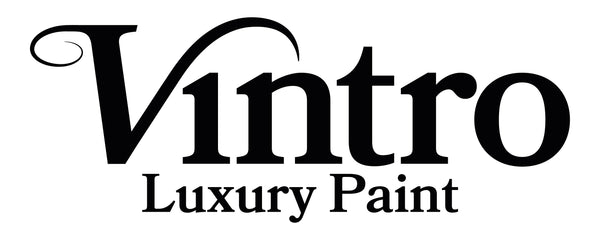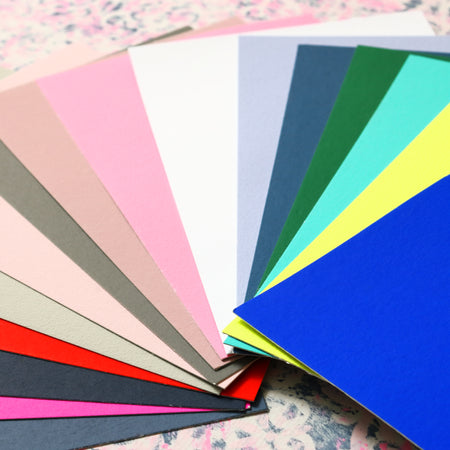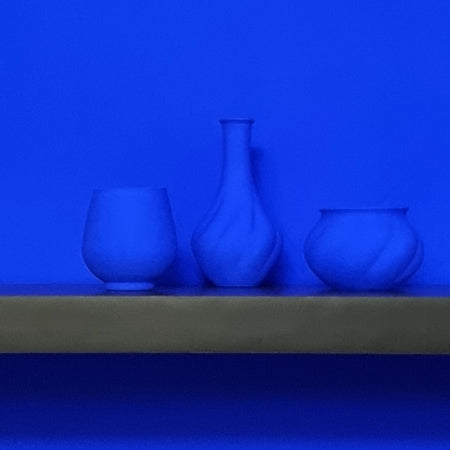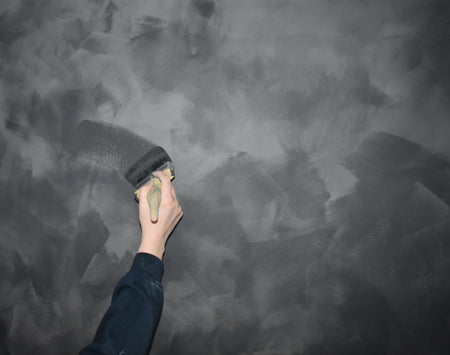Product Questions
Picking a paint finish should be based on what/where you are painting and what level of sheen you want.
Rooms with high moisture content and where the walls will need to be wiped down more would benefit being painted in Vintro Eggshell as this is a tougher finish than, say, Vintro Matt Emulsion. If you wanted to paint your kitchen or bathroom cabinetry, we would suggest painting these in either Vintro Eggshell, Vintro No Seal Paint or Vintro Gloss Paint for their durability. Whereas, if you were painting walls in your lounge, bedroom or snug we would suggest Vintro Matt Emulsion as this has a smooth, chalky feel that doesn’t reflect much light and therefore hides minor imperfections. Vintro Chalk Paint gives a lovely finish to furniture and if finished with Vintro Extreme Lacquer becomes washable or if finished with Vintro Wax becomes wipeable. Vintro No Seal Chalk Paint will give you a washable finish on furniture inside or outside your home Should you wish to paint your front door, we would suggest using either Vintro Eggshell, Vintro No Seal Chalk Paint or Vintro Gloss. Vintro Gloss Paint gives a lovely shiny finish to woodwork that is washable, however, it will show any imperfections in the painted surface due to the high sheen level.
Decide on the areas you want to paint measure it (height x width) to work out the square metre space to be painted. Add all the surfaces you want to paint together. Check the coverage (per square metre) of your chosen paint, you’ll find it in the product description or on the back of the tin.
Simply divide your surface area by the coverage. Most paints will require two coats, so multiply that result by two to make sure you have enough paint.
Yes! Neither our paints as a whole nor the constituent parts from suppliers of raw materials are tested on animals.
Our Concrete Effect Paint, Eggshell, Matt Emulsion, No Seal Chalk Paint, Chalk Paint and Extreme Lacquer are all child friendly and hold the Child Safe EN71-3 certification.
Vintro Paints all contain extremely low amounts of VOC and meet both British and European standards. No paint can be completely VOC free (British Coating Federation, 2022).
We have created paints that we want to use ourselves and therefore they have undergone rigorous testing for durability, environment and UV tests.
All Vintro paints are water-based and can technically be mixed, however, we would recommend that you only mix specific paint types together, for example mix eggshell paint with eggshell paint. Mixing two different paint finishes, such as eggshell and no seal chalk paint, will alter the characteristics of both paints and we could not guarantee the result.
Water-based paints technically should mix, however, the characteristics of the Vintro paint might become altered and we cannot guarantee that the paint will perform well or that you will get a good finish. Oil based paints would not mix with any of the Vintro Paints as they would not be compatible.
The level of sheen (how shiny) the paint is can not only affect how durable a paint finish is, but it will also affect how the colour appears. Both paint colours will be correct, however, for example, our matt emulsion will appear lighter than our gloss paint. This is because the gloss paint has a sheen level of 85%, compared to the matt emulsion which has a sheen level of 3%, and the gloss therefore will appear a much darker colour due to the way that light reflects off it.
Our paint is made in England with nearly all the components sourced within the United Kingdom.
If you have purchased two tins of Vintro paint of the same finish at different times and they have different batch numbers, we suggest that you mix them together before you start painting your project for consistency of colour.
To help keeping your Vintro paint finish at its optimal condition, we recommend that you avoid knocking or cleaning the surface until the paint has fully cured.
Most surfaces can be cleaned using a soft lint free cloth that has been dampened with water. Do not saturate the cloth. Lightly wipe the surface and dry the surface with a dry soft lint free cloth. The colour might darken whilst damp but should revert back to original colour once dry.
Do not use an abrasive cloth, a chemical cleaning agent or scrub the surface as this will damage the painted surface.
The coverage of each of Vintro’s paints and lacquers are found on the back of the tins. These rates are, however, a guide as they are affected by several variables beyond Vintro Paint’s control, including the thickness of paint coat when applied, the method of application, atmospheric temperature and air temperature, how porous the surface being painted is and what condition the surface is in. If you have watered down the paint, it will obviously go further however the coverage, opacity (covering power) and durability will be altered.
Clean up any spills of Vintro paint or lacquers immediately. Use a spoon or make a scoop out of cardboard to scoop up as much as the spillage as possible before using a warm soapy water solution and a clean cloth to clean what is left (keep changing the cloth as it becomes contaminated with paint or lacquer).
We highly recommend protecting floors and furniture with a drop sheet or dust cloth prior to painting.
Application Questions
For a perfect finish, we recommend that you stir the paint prior to painting and then stir regularly to ensure even distribution of ingredients and colour as these can become separated.
No Seal Chalk Paint does not usually need thinning, however, if it has become too thick to paint with, small amounts of water can be added*, we recommend adding a teaspoon of water at a time, before giving the paint a good stir.
*Adding too much water will alter the performance and colour of the paint.
This is dependent upon what and where you are painting.
For all jobs, you will need a few dust sheets to protect any surrounding areas and flooring. Fine to medium grade sandpaper to smooth any irregularities in the surface and to smooth any filler applied. A suitable filler for any holes or cracks. A scraper to remove flaking paint or plaster and peeling wallpaper and this can be used apply filler.
If you are painting a wall or ceiling with either Vintro Matt Emulsion or Vintro Eggshell, a 1 inch, 2 inch and/or 2½ inch quality flat synthetic brush to cut in or reach hard to paint areas. A large 4 inch flat synthetic brush suitable for painting walls or ceilings, with a paint roller and tray. Brushes can be found on Vintro Paint website.
When painting furniture with Vintro Chalk Paint we would suggest using a round synthetic brushes that will allow you to paint into corners, these are available on Vintro Paint website. If you are wishing to add texture to your piece, paint with a natural bristle brush as these will allow paint to be applied thickly and will show brushstrokes, available on Vintro Paint website. You will need a flat synthetic brush to apply Vintro Extreme Lacquer or a natural bristle brush to apply Vintro Clear or Vintro Dark Wax to finish your project. A small foam roller and tray can be used to paint flat areas.
We suggest that you use quality flat synthetic bristle brushes when you paint a project with Vintro No Seal Chalk Paint, these can be found on Vintro Paint website. A small foam roller and tray can be used for flat surfaces on furniture.
Vintro Concrete Effect Paint can be applied using a 4 inch synthetic flat brush for subtle shading, these can be found on Vintro Paint website or a block brush can be used. If you wish to create a broken concrete look, you will need a metal plastering trowel. You can apply first coat of paint with a paint roller and tray and will need a smaller synthetic brush to cut in.
For the best finish, we recommend prepping surfaces. Give your project a good clean with a mild soapy solution or sugar soap solution to remove any dust or possible contamination, rinse and allow to dry thoroughly. If there are any dents or holes in the surface, fill with a suitable filler and sand when dry to produce a smooth surface, cleaning away any loose dust. Lightly sand any loose flakes of paint or uneven surfaces with a medium grade sandpaper and wash away any loose dust, ensuring that the surface is completely dry prior to painting. Mask off with a good quality
masking tape any areas that you do not wish to paint. If you are painting onto raw wood, over any staining or over dark colours, you might wish to apply a coat of Vintro primer first.
If you are painting a piece of furniture, sand the piece with a medium grade sandpaper and wash away any loose dust, allowing it to dry prior to painting. Also consider removing any handles or masking any mirrors prior to painting. Depending upon the wood to be painting and the paint finish you are using, you might wish to apply a coat of Vintro Primer first.
Vintro Chalk Paint has superior adhesion qualities and will paint straight onto most surfaces; however, we do recommend that you at least give your project a thorough clean and allow it to dry prior to painting. However, for the best finish, we recommend lightly sanding your project prior to painting, especially if painting laminate furniture, such as Ikea flatpack or laminate flooring.
We recommend you stir all tins of Vintro's paint or lacquer prior to application. If the tin has been open for some time, we recommend that you stir periodically. Stirring ensures an even distribution of colour throughout the paint..
A greasy surface can commonly occur on an old piece of furniture that you want to paint or your kitchen cabinet doors. Firstly, we recommend that you give your project a good clean with a mild soap solution or sugar soap solution, rinse and allow to dry. The surface should then be wiped over with a clean mineral spirit, before being washed again. This should be enough to remove any grease, if any grease remains, go through the cleaning process again, including the clean mineral spirit and then apply a coat of primer to your project and this will hopefully block any grease marks.
Paint being thrown off your paint roller in small droplets has a few possible causes including, thinning of paint, putting too much paint on your roller, applying paint too quickly, using the wrong roller cover for the paint type (wrong pile) or overworking the paint once this has been applied to the surface.
Should this problem occur, firstly try altering your application technique and secondly, change the roller sleeve to a different pile – for most paint jobs a short or medium pile is suitable. A foam roller can be used to apply Vintro Chalk Paint. Please contact us directly for advice on thinning your Vintro Paint.
Vintro Chalk Paint is a thick and creamy paint that is loaded with pigment and it will become thicker in a closed tin dependent upon how it has been stored and will thicken up as you are painting if the lid has been off the tin for some while. Vintro Chalk Paint will become more fluid if you give it a good stir. Should the paint remain too thick, we recommend decanting some paint out of the tin and adding small amounts of water* such as a teaspoon full at a time to thin the paint, before thoroughly stirring again.
*Adding too much water will alter the performance and colour of the paint.
Problem Solving
Wrinkling produces a rough, cracked paint surface and has several causes including applying the paint too heavily, painting onto a dirty or contaminated surface, painting onto a hot surface, painting in hot weather, high levels of moisture in the air when painting or applying second coat of paint before the first coat is sufficiently dry.
To rectify, scrape or sand off any wrinkling until you get a smooth surface and repaint. Allow for sufficient drying time between coats and extra time for curing if there are high levels of moisture in the air.
Runs or sagging on the paint surface can happen if the paint has been thinned too much, the paint is applied too thickly, using a spray-gun too close to the surface.
To fix this problem, roller or use a brush to evenly spread the paint if it is still wet. Once dry, sand off any runs/sagging until you have a smooth surface and apply a new top coat.
This usually occurs when the paint lifts from the surface, commonly caused by excessive moisture or heat, or a combination of both and can affect the paint adhesion leading to peeling. Modern homes are quite airtight and therefore excess amounts of moisture in the air can be generated during the painting process as the paint dries. To prevent this and to aid the paint drying and curing, we suggest that you open your window to allow constant airflow but ensure that the room does not get too cool but using a heater if needed. Blistering of paintwork can also occur when the heat from direct sunlight is constantly hitting the same area of paint for long periods.
When painting outside, if the surface is wet prior to painting moisture may get trapped as the paint dries and can lead to blistering. Blisters can also occur if there has been a period of rain/heavy dew whilst the paint is drying - horizontal surfaces are more likely to be affected.
To correct, address any underlying problem. Scrape or sand off the blisters/bubbles until you get a smooth flat surface and repaint. Allowing sufficient time for drying between coats and extra time for curing if there are high levels of moisture in the air.
A white sheen or white steaks on your dried painted surface is a cosmetic problem rather than a paint durability problem. This is called surfactant leaching and commonly occurs when there is poor drying conditions for the paint, such as too much moisture in the air, cool temperatures and lack of ventilation/air flow. This mean that the paint dries to slowly allowing the surfactants in the paint to rise to the surface leaving streaking or deposits. This is more noticeable on darker colours, for example Woodpecker green, Victorian Black, Ribwort brown or Nightfall blue. Surfactant leaching can also occur in rooms such as bathrooms where a steamy shower or bath has been run before the paint on walls has had sufficient time to cure. This problem can be rectified by wiping down the paint surface with a damp cloth, allowing to dry, repainting and allowing sufficient ventilation and time for paint to dry between coats and to cure.
Cracking and flaking are problems that occur as the paint surface splits. Initially, you will see a hairline crack in the paint surface that can progressively develop into the cracking or flaking of the paint surface. The probable causes of this are poor preparation of surface, including imperfect underlying coats of paints, using Vintro water-based paint products over oil-based paints without adequate preparation, the introduction of excessive/sitting water onto the surface, applying the paint too thinly or watering down the paint excessively before use.
If the cracking/flaking is minimal it might be able to be corrected by simply removing the cracking/flaking by scraping any loose paint off the surface, lightly sanding to a smooth finish, clean and applying a new layer of paint. If the cause is imperfect base layer or oil-based paint, we recommend that you remove all the paint by sanding, give your base layer a good sand to remove imperfections and to give it a key, before giving it a clean. Apply a suitable primer such as Vintro primer, allow to dry and repaint with your chosen Vintro finish. Allow for sufficient drying time between coats and extra time for curing if there are high levels of moisture in the air.
Poor sheen uniformity shows as dull or shiny spots on the painted surface. This can be caused by over thinning of paint, poor application of paint, painting onto a porous surface without doing adequate preparation and not maintaining a ‘wet edge’ when painting.
For uniformity on a porous surface, apply a coat of either Vintro Primer or Vintro Extreme Lacquer and allow to dry for 24 hours before applying the topcoat. To maintain a ‘wet edge’, by applying paint towards the unpainted surface and then back to the wet just painted surface.
Orange or pink staining is often caused by tannins, dyes or old stains showing through the paint from the underlying surface and is commonly called “bleed-through”. This can be a problem when painting furniture and is often seen when painting wooden surfaces made from cedar, mahogany, oak, redwood or the knots from new wood. Stains can also show through if you have had a water leak on a wall or ceiling.
These stains can be prevented or blocked by using a coat of Vintro Primer or a coat of Vintro Extreme Lacquer, allow to dry for at least 24 hours, prior to painting with your Vintro topcoat. If you have already painted your project, apply a coat of Vintro Extreme Lacquer, allow to dry for 24 hours before applying another coat of your chosen Vintro Paint.
Peeling can be caused by poor preparation of surface including, imperfect underlying coats of paint, excessive water/moisture on the surface, using Vintro Paint water-based products directly over oil-based paints without adequate preparation and previous blistering/bubbles/cracking or flaking of underlying base paint.
If the peeling is minimal, it might be able to be corrected by simply removing the cracking/flaking by scraping any loose paint off the surface, lightly sanding to a smooth finish, clean and applying a new layer of paint. If the cause is imperfect base layer or oil-based paint, we recommend that you remove all the paint by sanding, give your base layer a good sand to remove imperfections and to give it a key, before giving it a clean. Apply a suitable primer such as Vintro primer, allow to dry and repaint with your chosen Vintro finish. Should there be a problem with moisture/excessive water on the surface, this will need to be rectified before repeating preparation steps and repainting.
Order and Delivery Questions
Should you wish to make any changes to your Vintro Paint order, please contact us immediately as orders will be processed before 1pm the following working day when it will be despatched. You can contact us by telephone on 01937-845764.
For most of our products, it is a 1 day processing time, (Mon-Fri), then the order is ready to be dispatched. There are options on delivery, 3 working days or Express 1 working day. A working day is classed as (Mon-Fri).
You will be provided with tracking details once your order is despatched.
We use Royal Mail, DPD and DHL and is dependent upon the weight of the parcel and the delivery location.
Please see our returns policy.



